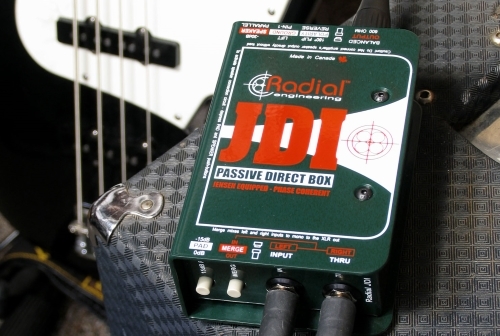Dear Jonah:
What, exactly, does a DI (direct box) do? – Joya G., Brooklyn, NY
A few things, actually. DI (direct injection) boxes come in two flavors – passive, which use a transformer, and active, which use electronic circuitry. But the application is the same: DIs allow us to interface electronic signals with mixers.
Specifically, they condition signals from a variety of sources into a mic-level, low-impedance, balanced signal that the preamp is expecting. Let’s take these topics one at a time.
Devices with active outputs (keyboards, laptops, CD players) operate at line level. There are two main standards for line level: professional (+4 dBu, 1.23 volts) and “prosumer” (-10 dBV, 0.3 volts). Both are a far higher voltage than a mic-level signal, which is measured in thousandths of a volt [millivolt, mV]. A DI steps down the signal voltage to prevent the mic preamp from being overloaded.
Passive models do this with a transformer, usually having a turns ratio of about 12:1, or about 22 dB. Some models offer pads, which are internal attenuators that can be switched in to further reduce signal level.
Active DIs may also have pads, but most engineers usually opt for a passive unit on an active source to minimize the number of active gain stages in the signal chain. For any device outputting a line level signal, I’m going to reach for a passive DI.
OK, we have the voltage level under control. Next, we deal with impedance. Those fuzzy on how impedance affects signal flow may want to review my two-part series on the topic (Part 1 and Part 2).
Simply put, sources like guitar and bass pickups have a high-output impedance, which means that it’s hard for them to drive signal adequately on long cables without significant losses. The weak signals are unduly affected by cable capacitance, which causes HF losses, and by radio and electromagnetic interference (RFI and EMI), which cause humming, buzzing, and other funny noises.
It can be tricky to conceptualize, but basically, the transformer helps the mic preamp appear as a much lighter load than it actually is, so the output device doesn’t have to work as hard to provide signal current.
A decent analogy would be changing to a low gear on a bicycle to more easily pedal up a big hill. The reduction in gear ratio provides isolation from the hard work of turning the little gear on the rear wheel. The transformer does more or less the same thing, keeping the source from breaking a sweat. The resulting low-impedance signal can easily drive signal down long cables with negligible losses. The active DI uses op-amp buffers for the same purpose.
Finally, the DI balances signal. The unbalanced signal coming from most instruments (and DJ gear with those darn RCA jacks) can’t reject RFI or EMI since the cable’s shield is part of the signal circuit. Unbalanced cable runs of more than 10 feet should make you nervous.
The DI creates a balanced signal, which uses a pair of signal conductors carrying the same signal voltage but in opposite polarities, like yin and yang. Any interference that makes it past the shield is (in theory) picked up equally in both signal conductors.
The mic preamp is responsive only to differential-mode signals (the difference between the two conductors, and will reject (in theory) common-mode signals such as the interference picked up along the way. So when the preamp subtracts the two signal conductors from each other, the noise cancels out, leaving just the face-melting guitar solo.
So there you have it – a DI will convert a source to a mic-level, low-impedance, balanced signal. By the way, if there’s an annoying hum, hit the Ground Lift switch on the DI. This breaks the “ground loop” circuit formed by the cable shield and the venue’s ground wiring. Absolutely never try to break a ground loop by defeating the third prong on the electrical plug of a device. This will stop the hum, but it can be – and has been – fatal.
Got a question? Send it to Jonah via email at [email protected].















